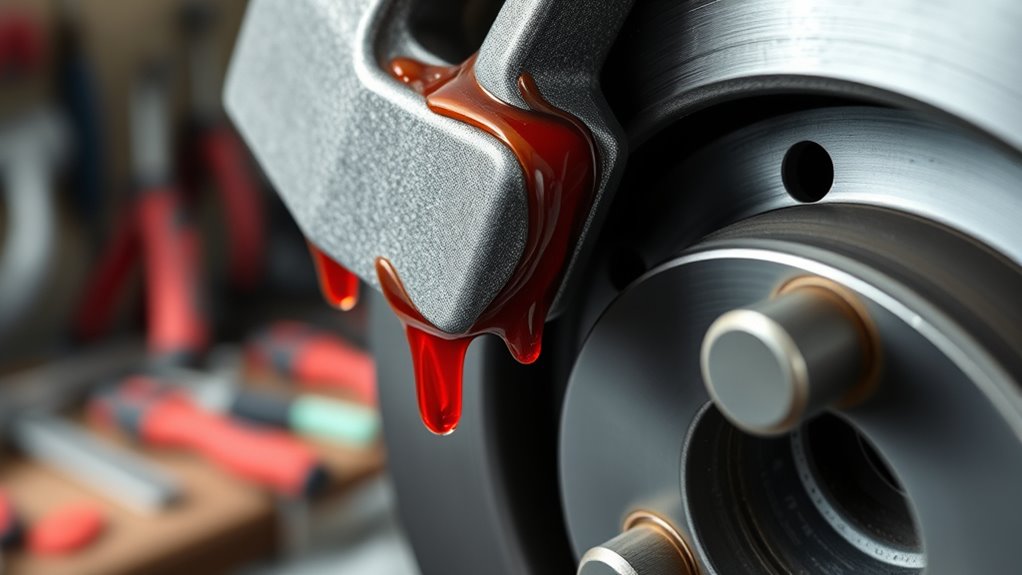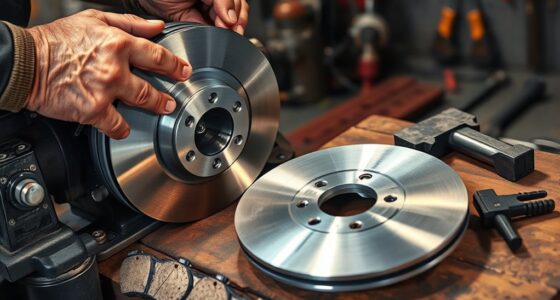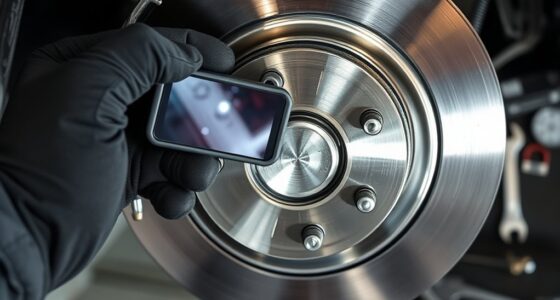When bleeding brakes, gravity bleeding is simple and gentle, relying on opening the bleeder valve and letting fluid and air escape naturally—it’s slower but reduces the risk of damage. Pressure bleeding uses a device to force brake fluid through the lines quickly, making the process faster but needing careful monitoring to avoid over-pressurizing. Choosing the right method depends on your experience and tools; more details can help you decide which suits your situation best.
Key Takeaways
- Gravity bleeding is a slower, simpler method that uses natural flow by opening the bleeder valve and letting fluid drain.
- Pressure bleeding employs a device to force brake fluid through the lines, offering faster results.
- Gravity bleeding minimizes equipment needs and reduces risk of over-pressurizing the system.
- Pressure bleeding requires careful pressure control to prevent damage and ensure complete air removal.
- Both methods require monitoring fluid levels and checking for leaks to ensure effective brake system bleeding.

If your brake pedal feels soft or sinks to the floor, it’s a sign that your brake system needs bleeding. This process removes air bubbles from the brake lines, restoring proper pedal feel and braking performance. Before you begin, it’s essential to understand the different brake fluid types, as using the wrong one can compromise safety and effectiveness. Most vehicles use DOT 3, DOT 4, or DOT 5.1 brake fluids, each with specific boiling points and compatibility requirements. Check your owner’s manual to identify the correct brake fluid for your vehicle. Using incompatible brake fluid or neglecting to choose the right type can lead to brake failure or damage to the system. When handling brake fluid, always observe safety precautions. Wear gloves and eye protection, as brake fluid is corrosive and can damage paint or skin. Work in a well-ventilated area, and clean up any spills immediately. Never reuse old brake fluid, and dispose of it properly, following local regulations. Properly bleeding your brakes also helps prevent corrosion and prolongs the life of your brake components, which is especially important given the importance of maintaining water park safety and vehicle reliability.
Once you’ve prepared, you can choose between gravity bleeding and pressure bleeding methods. Gravity bleeding is simpler and involves opening the bleeder valve and letting gravity do the work. You open the valve, have someone press the brake pedal, then close the valve before releasing the pedal. Repeat until no air bubbles are seen in the fluid. This method takes longer but minimizes equipment and complexity. Pressure bleeding, on the other hand, uses a pressure or vacuum device connected to the brake fluid reservoir. It forces brake fluid through the lines, quickly flushing out air. This method is faster but requires special equipment and careful attention to avoid over-pressurizing the system.
Both methods demand safety precautions. When working with pressurized systems, always monitor the pressure carefully. Over-pressurizing can cause damage or leaks. Keep an eye on the fluid reservoir to prevent it from running dry, which could introduce more air into the lines. After bleeding, check for leaks and ensure the brake pedal feels firm and responsive. If it still feels spongy, repeat the process or consider consulting a professional. Proper bleeding restores your braking system’s integrity, ensuring safe and reliable stopping power. Remember, whether you choose gravity or pressure bleeding, patience and attention to detail are key to a successful brake bleed.
Frequently Asked Questions
Can I Bleed My Brakes Without Any Special Tools?
Yes, you can bleed your brakes without special tools by using a simple DIY maintenance method. Just open the brake fluid reservoir and have a friend press the brake pedal while you loosen the bleeder valve to release air bubbles. Make sure to use the correct brake fluid types for your vehicle. This method works well for basic bleeding, but for more thorough maintenance, consider investing in a brake bleeding kit.
How Often Should I Bleed My Brakes?
You should bleed your brakes whenever you notice a spongy pedal or reduced braking performance, typically every 2-3 years. During the bleeding procedure, you’ll replace old brake fluid with fresh fluid to prevent air bubbles from affecting brake efficiency. Regularly checking and bleeding your brakes guarantees the brake fluid remains clean and effective, maintaining safe stopping power. Always follow your vehicle’s recommended maintenance schedule for ideal safety.
Is It Safe to Drive Immediately After Bleeding Brakes?
You shouldn’t drive immediately after bleeding your brakes, as brake fluid contamination might still be present, risking brake failure. Give the system time to settle, and check that your brake pedal feels firm and responsive. Driving too soon can compromise safety, so wait until you’re confident the brake pedal firmness is restored and the fluid is clean. This guarantees your brakes work effectively and keeps you safe on the road.
What Are Signs of Improper Brake Bleeding?
You’ll notice signs of improper brake bleeding if your brake pedal feels spongy or sinks too easily, indicating air pockets formation. Also, if you experience a soft pedal or inconsistent braking, it could be due to brake fluid contamination or trapped air. These issues compromise your stopping power, so it’s essential to re-bleed the brakes correctly to remove air pockets and make sure your brake fluid is clean for safe driving.
Can Brake Fluid Leaks Affect the Bleeding Process?
Think of the bleeding process like a delicate chain, where a brake fluid leak is a broken link. If you have brake fluid leaks, it can seriously disrupt the bleeding process, making it hard to remove air from the system. Leaks cause pressure loss and introduce new air, compromising brake performance. So, fixing leaks first guarantees your brake fluid flows smoothly, helping you bleed the brakes effectively and safely.
Conclusion
Think of bleeding your brakes as releasing the weight of doubt, whether you trust gravity’s gentle pull or the force of pressure. Both methods clear the path for smooth stops, like clearing fog from your mind. Remember, patience is your guiding star, ensuring every bubble and air pocket is gone. When you finish, your brake pedal will feel solid, a symbol of control regained. Trust your process—your safety depends on it.









